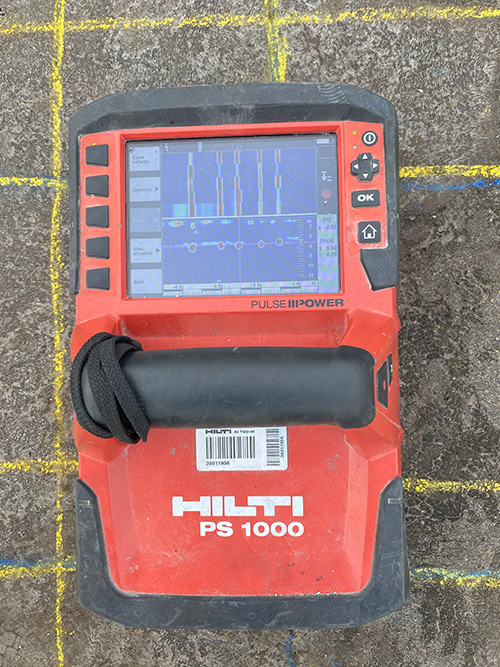Introduce the Transformative Power of Concrete Scanning in Making Best Use Of Performance and Security
Concrete scanning has actually emerged as a vital device in the construction sector, offering unmatched benefits in boosting job effectiveness and ensuring safety and security requirements. By utilizing innovative innovation, concrete scanning enables professionals to see past the surface, revealing covert intricacies that might impact the architectural stability of a building. The transformative power of concrete scanning lies in its capacity to give in-depth understandings and real-time data, reinventing just how projects are prepared and implemented. As we look into the ins and outs of this cutting-edge technique, a world of opportunities opens, showcasing a new age of building and construction practices that prioritize accuracy and protection.
Value of Concrete Scanning
Making sure the structural stability and safety of building and construction projects starts with the essential action of carrying out extensive concrete scanning. Concrete scanning is a non-destructive method utilized to detect and map subsurface aspects within concrete frameworks.
Additionally, concrete scanning assists in maximizing task timelines and budget by avoiding unexpected costs and delays that might arise due to unforeseen obstructions within the concrete. Ultimately, investing in complete concrete scanning is an aggressive strategy that enhances both efficiency and safety in building jobs.
Exactly How Concrete Scanning Works
Concrete scanning runs as an essential device in construction projects by utilizing advanced technologies to detect and map subsurface components without creating architectural damage. Ground Penetrating Radar (GPR) and Electromagnetic Induction (EMI) are 2 main methods used in concrete scanning. GPR jobs by sending out high-frequency radar pulses right into the surface, which recuperate when they run into subsurface items or voids. The time considered the signal to return suggests the depth and area of the items. EMI, on the various other hand, utilizes electromagnetic areas to determine variances in product compositions, such as recognizing rebar or channels within concrete structures.
Throughout the scanning procedure, the data gathered is assessed in real-time, enabling prompt recognition of potential risks or challenges underneath the surface area. By using these innovative technologies, concrete scanning substantially lowers the risk of costly damages and injuries on building websites.
Advantages of Concrete Scanning
Utilizing advanced scanning innovations in building jobs uses a plethora of benefits, boosting both efficiency and security on-site. Among the key benefits of concrete scanning is the capability to detect and locate embedded objects such as rebar, post-tension cable televisions, and avenues accurately. By identifying these components before boring or cutting into concrete frameworks, the risk of unintentional strikes is considerably minimized, protecting against possible injuries to workers and damages to the framework itself. In addition, concrete scanning aids in preparation and creating better, as it supplies specific details concerning the area and deepness of architectural parts.

Situation Researches: Concrete Scanning Success

In another instance, a building company used 3D concrete scanning to assess the problem old concrete structures in a historic building. The in-depth scans provided beneficial insights right into the extent of damage and assisted prioritize upkeep official site efforts efficiently. By proactively dealing with locations of worry recognized with scanning, the company was able to expand the lifespan of the structure and guarantee occupant safety and security.
These study highlight the transformative power of concrete scanning in enhancing effectiveness, accuracy, and safety and security in construction tasks.
Implementing Concrete Scanning in Projects
Carrying out innovative scanning innovations during construction jobs has actually ended up being significantly important for improving accuracy and security. By incorporating concrete scanning into job planning and execution, building and construction teams can determine possible threats, such as rebar or post-tension wires, hidden within concrete structures. This proactive approach minimizes the risk of crashes, hold-ups, and pricey rework, inevitably bring about extra reliable project timelines and budgets.
To look what i found apply concrete scanning properly, task managers ought to collaborate closely with experienced scanning professionals to establish one of the most ideal scanning strategies for the certain task demands. Engaging scanning experts from the early stages of a project enables the group to develop thorough scanning strategies that attend to crucial areas of issue and guarantee extensive data collection.
Moreover, including concrete scanning into routine job workflows can streamline decision-making procedures, as real-time scan information supplies prompt understandings into the condition of concrete frameworks - Concrete Scanning. This data-driven method helps with informed problem-solving and enables groups to make changes promptly, cultivating a society of performance and security throughout the project lifecycle

Conclusion
In conclusion, concrete scanning plays a vital role in improving performance and security in building tasks. By utilizing sophisticated modern technology to spot and map out underlying structures within concrete, this process assists to prevent expensive errors, make certain structural integrity, and reduce dangers on site. With the capability to reveal hidden aspects and supply exact information, concrete scanning confirms to be an important tool for enhancing task outcomes and optimizing general success.
Concrete scanning is a non-destructive approach made use of to find and map subsurface components within concrete frameworks. Furthermore, concrete scanning assists in enhancing job timelines and spending plan by avoiding unanticipated prices and hold-ups that might occur due to unanticipated obstructions within the concrete. One noteworthy situation research study includes a massive restoration project where concrete scanning played an important function in guaranteeing project success.In another instance, a building and construction firm used 3D concrete scanning to examine the problem of aging concrete helpful resources structures in a historical structure. By integrating concrete scanning into task preparation and implementation, building teams can recognize prospective risks, such as rebar or post-tension cables, concealed within concrete frameworks.
Comments on “Selecting the Right Concrete Scanning Equipment”